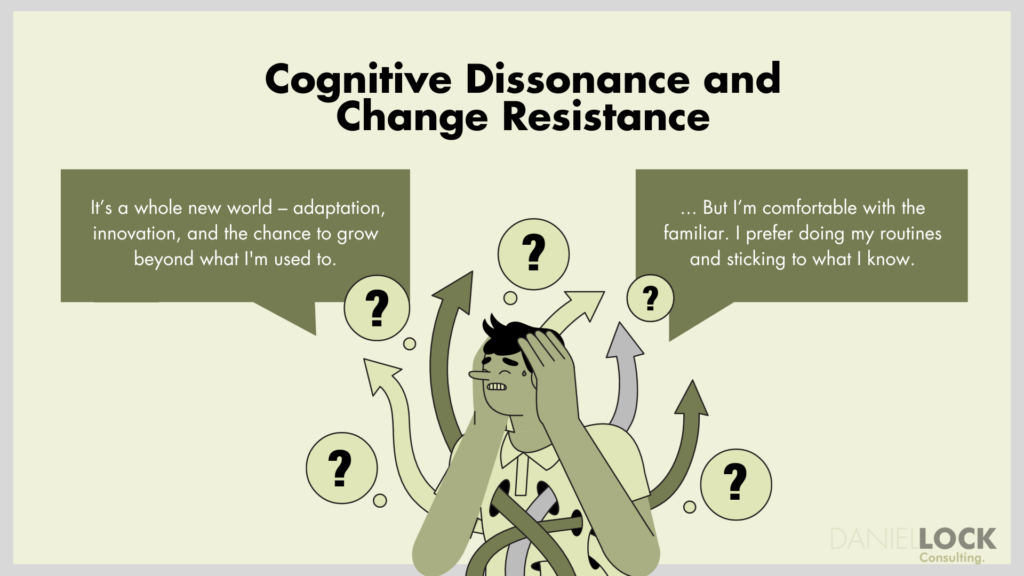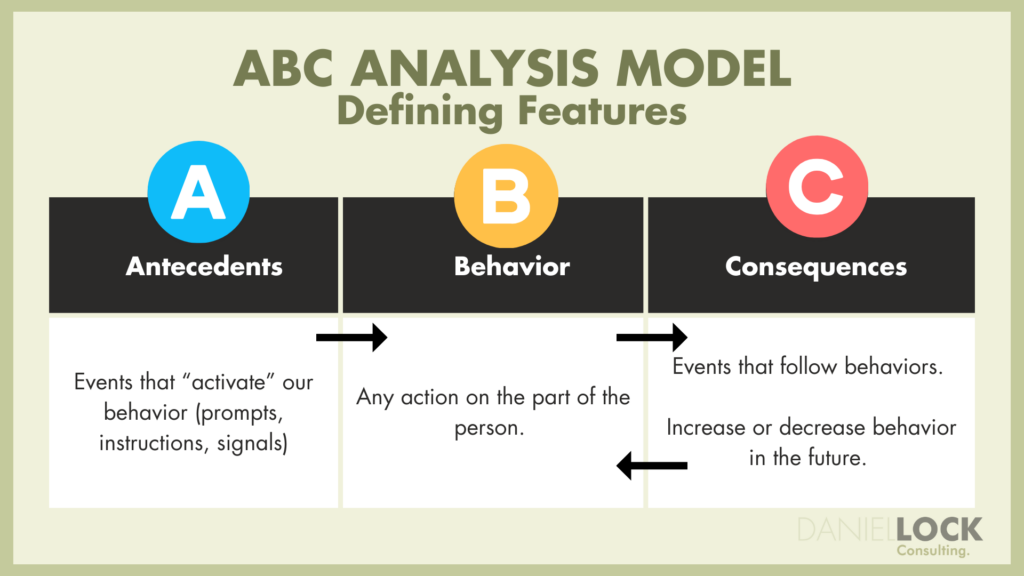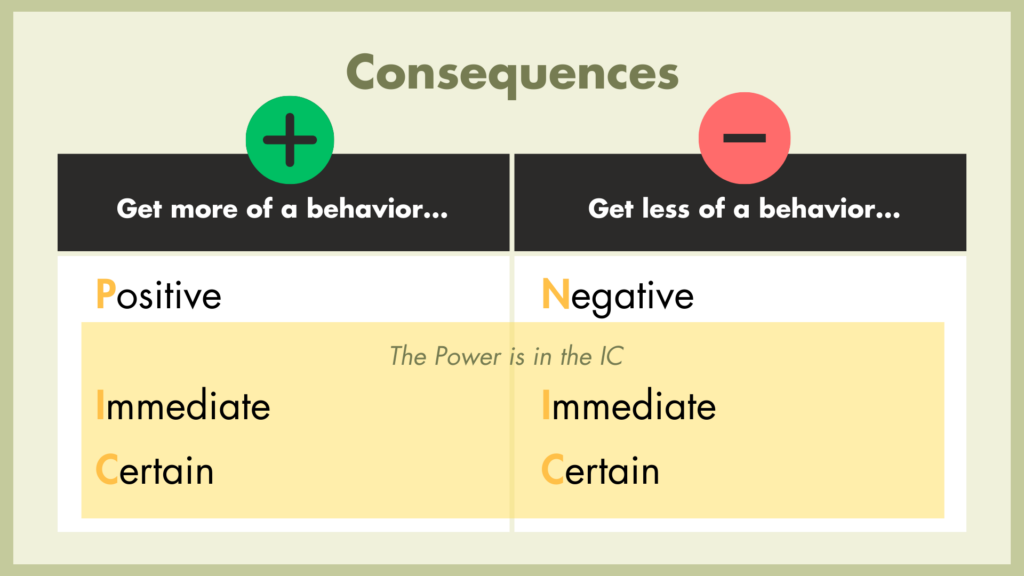Organisations are not “things” in and of themselves. The are made of people – individuals – who in the end must change their behavior collectively for a given change initiative to be successful.
Therefore it makes sense to have an overview of the psychology of change management as people move through the various stages of change.
I am not a psychologist or even an organisational psychologist and you don’t need to be one to lead and manage change either. Let’s explore the various psychological factors that can make or break change initiatives and learn how to harness the psychology of change management to create lasting, positive transformations in your organization.
Key Takeaways
- Understand the power of mindsets in change management
- Address cognitive dissonance and promote a growth mindset
- Foster trust with transparent communication & reward desired behaviors
- Recognize the importance of choosing the right change management model.
The Power of Mindsets in Change Management
At its core, change management is about people. While processes, tools, and strategies are essential, the success of any change initiative largely depends on the people involved. Understanding the psychological aspects of change helps in addressing the human element effectively.
- People tend to Resistance to Change: Humans are naturally resistant to change due to fear of the unknown, loss of control, or concerns about competence. By understanding the psychology behind this resistance, leaders can devise strategies to mitigate it.
- People have Predictable Reactions: Psychological models, such as the Kübler-Ross Change Curve, predict how people typically react to change. This knowledge allows organizations to anticipate reactions and plan accordingly.
- Sustainable Change is possible: To create sustainable change, you need to have it internalized by individuals. An understanding of psychology can help ensure that change isn’t just a superficial shift but is deeply rooted in the beliefs and behaviors of individuals.
The key lies in focusing on employees’ mindsets during change programs.
These mindsets play a crucial role in hitting company goals, as they determine how employees perceive, respond to, and ultimately embrace organizational changes.
There are four conditions required to achieve a successful change in mindset and motivate change.
- Employees need to understand the reasons behind the change.
- The environment must support new behaviors.
- They must have the necessary skills and know-how.
- They must see consistent role models embodying the desired changes.
When leaders confront these tangible factors, they can successfully overcome resistance and bring about enduring, significant changes within their organization.
Factors affecting mindset

Cognitive Dissonance and Change Resistance
Cognitive dissonance is the mental discomfort experienced when trying to reconcile conflicting beliefs, values, or attitudes, which often occurs during organizational change. This psychological phenomenon can lead to resistance, as people struggle to make sense of the new information and align it with their existing beliefs and value
For example, when an employee is asked to adopt new skills and behaviors, they may experience cognitive dissonance if they feel their current abilities are insufficient to behave differently. This resistance can be addressed by helping employees understand the reasons behind the change and offering support to develop the required skills.
Leaders can enable smoother transitions and cultivate a culture of adaptability by recognizing and responding to cognitive dissonance.
Growth Mindset vs. Fixed Mindset

The way employees perceive their own abilities can significantly impact their response to change.
A growth mindset, which is the belief that intelligence and abilities can be improved through hard work and learning, encourages individuals to embrace new challenges and view change as an opportunity for growth. Senior managers should promote a growth mindset culture to facilitate change.
On the other hand, a fixed mindset assumes that intelligence and abilities are unchangeable, leading to resistance and a fear of failure when faced with change.
Appreciating the influence of these mindsets enables leaders to motivate employees effectively, fostering the adoption of new behaviors and enhancing adaptability amid change.
Understanding Human Responses to Change:
We can categorise the psychological responses into three:
- Emotional Responses: Delve into the common emotional reactions people have when faced with change, such as fear, anxiety, excitement, or resistance. The Kübler-Ross Change Curve is a model that can help understand these reactions
- Cognitive Responses: Explore how individuals process information about change, including their beliefs, perceptions, and misconceptions. This can also touch on cognitive biases that might affect how change is perceived.
- Behavioral Responses: Discuss the typical behaviors people exhibit in response to change, from resistance and denial, to acceptance and advocacy.
Overcoming Common Psychological Barriers to Change
To ensure a successful change process, leaders must address and overcome common psychological barriers, such as overconfidence, ego traps, and the tragedy of the commons. By providing necessary information and creating a supportive environment, leaders can help employees overcome these barriers and fully engage in the change process.
Comprehending and responding to these psychological barriers empowers leaders to:
- Devise strategies that mitigate resistance
- Foster a positive change environment
- Eventually result in a more triumphant and enduring transformation within their organization.
Loss Aversion and the Endowment Effect
Loss aversion and the endowment effect are psychological phenomena that can significantly impact an individual’s response to change. Loss aversion refers to the tendency to prefer avoiding losses over acquiring equivalent gains, while the endowment effect is the tendency to place a higher value on items we already own.
To address these barriers, leaders must ensure that the potential future state of the proposed changes is more attractive than what employees may lose by letting go of the old way of working. Leaders can assist employees in overcoming loss aversion and the endowment effect, minimize resistance and stimulate acceptance of the change by highlighting the benefits and offering essential support.
Anchoring and Confirmation Bias
Anchoring and confirmation bias are cognitive biases that can hinder effective change management. Anchoring occurs when individuals overly rely on the first piece of information they receive, while confirmation bias refers to the tendency to seek out information that confirms preexisting beliefs.
Addressing these biases is crucial for successful change management, as they can impact culture and communication within the organization. Leaders can assist in overcoming these biases and achieve a more effective and inclusive approach to change management by fostering an environment that promotes open-mindedness and actively involves employees in the change process.
Strategies for Facilitating Positive Change:
Emphasize the importance of clear, consistent, and empathetic communication. Discuss strategies for effective communication that addresses concerns and provides clarity.
Communication: The Role of Communication in Change Management
Understanding the psychology of change helps leaders tailor their communication to address concerns, fears, and hopes of their teams. [added]
Effective communication is a crucial component of successful change management. It helps create awareness, build understanding, and ensure everyone is on the same page regarding the need for change. Moreover, communication strengthens trust, as employees gain a clear understanding of the reasons behind change, and are more likely to accept it.
During organizational transformation and cultural change, clear and consistent communication plays a vital role in keeping everyone aligned and working toward the same objectives. Addressing potential issues and formulating solutions through communication can bolster organizational success and maintain agility amidst change.
Tailoring Messages to Different Audiences
Customizing messages for different audiences is essential for successful communication and engagement. By understanding the unique needs, preferences, and characteristics of various groups, leaders can craft messages that resonate with each audience, increasing the likelihood of capturing their attention and influencing their behavior.
There are numerous ways to tailor messages, such as:
- Using different language, visuals, or stories to appeal to different age groups
- Adjusting the tone to be more formal or informal
- Utilizing different communication channels like email, text, or social media.
Customizing messages allows leaders to:
- Foster trust and credibility
- Make audiences feel acknowledged and valued
- Enhance communication effectiveness
- Increase the likelihood of accomplishing targeted results.
Engagement:
Highlight methods to involve stakeholders in the change process, ensuring their buy-in and commitment. This can include workshops, feedback sessions, and collaborative planning.
Transparency and Trust-Building
Transparency is key to building trust during change management. By being open and honest about the change process, leaders can create an environment of openness and understanding, reducing resistance to change. Leaders can demonstrate transparency by clearly explaining the reasons for change, keeping everyone informed about progress, and being receptive to employee feedback and concerns.
Building trust with employees involves honest communication, demonstrating dedication to the change process, and respecting their thoughts and ideas. Leaders can simplify the acceptance and full commitment to change for employees by cultivating trust and understanding.
Training & Support
Effective change management hinges on equipping employees with the necessary skills and knowledge. Comprehensive training programs tailored to specific roles ensure that everyone understands the nuances of the new systems or processes. But training shouldn’t end at the workshop.
Continuous support, through dedicated help desks, online resources, and peer support groups, ensures that employees have a safety net to fall back on. This combination of structured training and ongoing support not only smoothens the transition but also empowers employees to embrace change with confidence and resilience.
Motivating Employees through Reinforcement Systems
Reinforcement systems play a significant role in motivating employees to adopt new behaviors and support change management. These systems, which include reporting structures, management processes, and performance measurement, must align with the desired behaviors to effectively encourage change.
Positive reinforcement, such as rewards or praise for desired behaviors, can help motivate employees to continue and even increase these behaviors in the future.
However, negative reinforcement, like punishing employees for undesirable actions, can hinder trust-building and make change management more difficult. Therefore, the establishment of reinforcement systems that stimulate and reward preferred behaviors by leaders is imperative.
The Antecedent-Behavior-Consequence (ABC) Model in Reinforcement Systems
A foundational concept in behavioral psychology, the Antecedent-Behavior-Consequence (ABC) Model, provides a structured approach to understanding and influencing behavior, making it particularly relevant in change management.

- Antecedent: This refers to the events, environment, or circumstances that trigger a particular behavior. In an organizational context, antecedents could be a new policy, a team meeting, or even a casual conversation between colleagues. By setting the right antecedents, leaders can create an environment conducive to desired behaviors. For instance, regular training sessions can be an antecedent that encourages skill development.
- Behavior: This is the action or response that follows the antecedent. In change management, the behavior is what leaders aim to influence. It could be employees adopting a new software tool, adhering to a new company policy, or collaborating in new ways.
- Consequence: This is the result or outcome that follows the behavior. Consequences following a behavior can be multifaceted. They can be:
- Positive or Negative: Positive consequences (like rewards or praise) encourage the repetition of a behavior, while negative consequences (like reprimands or penalties) discourage it.
- Immediate or Delayed: Immediate consequences occur right after the behavior, making them more impactful in influencing future actions. Delayed consequences, while still influential, might not have the same direct impact due to the time lapse.
- Certain or Uncertain: Certain consequences, which are guaranteed to happen after a behavior, have a stronger influence than uncertain ones, which might or might not occur.

The most potent consequences in driving behavior are those that are positive, immediate, and certain. For instance, immediately praising an employee after they’ve demonstrated a desired behavior ensures they’re more likely to repeat it.
Conversely, to reduce an undesired behavior, consequences should be negative but still immediate and certain.
However, it’s preferable to focus on positive reinforcement, as it fosters a more constructive and motivating environment.
While both positive and negative consequences have their place in shaping behavior, the key is in their immediacy and certainty to ensure effectiveness.
By understanding and applying the ABC model, leaders can create reinforcement systems that effectively motivate employees. By setting clear antecedents, observing behaviors, and applying appropriate consequences, organizations can drive desired behaviors and ensure the success of change initiatives.
Leading by Example: The Importance of Consistent Role Models
If there were one thing that could inspire and motivate and influence psychology the most it is Leadership and leading by example.
Consistent role models, including middle managers, are crucial in leading change management, as they demonstrate commitment to the change and encourage a culture of adaptability. Leaders at all levels must lead by example, embodying the desired changes and inspiring others to follow suit.
Group dynamics play a significant role in the influence of role models. To ensure lasting behavior change, the new behaviors must be accepted by the group. This makes the presence of consistent role models throughout the organization vital for change management success.
Demonstrating Commitment to Change
Leaders can actively demonstrate their commitment to change by getting involved, setting a good example, and providing support and resources to employees involved in the change process.
By showing their dedication and actively participating in the change, leaders can inspire employees to fully commit to the transformation.
When Satya Nadella took the helm as Microsoft’s CEO in 2014, he faced a company at a crossroads. Microsoft, once the undisputed leader in the tech industry, was grappling with declining PC sales, missed mobile opportunities, and a somewhat stagnant corporate culture.
Nadella’s leadership approach was a masterclass in change management:
- Growth Mindset: One of Nadella’s first acts was to shift the company culture towards a growth mindset. He encouraged employees to learn from failures and view them as opportunities to grow rather than setbacks. This was a significant departure from the previous culture, which was often seen as competitive and unforgiving.
- Embracing the Cloud: Recognizing the future of technology, Nadella pivoted Microsoft to focus on cloud computing. Under his leadership, Microsoft Azure has grown exponentially and is a close competitor to Amazon’s AWS.
- Inclusivity and Collaboration: Nadella emphasized the importance of teamwork and collaboration. He broke down silos within the company, encouraging different departments to work together rather than compete. He also championed diversity and inclusion, making it a core part of Microsoft’s mission.
- Acquisitions and Partnerships: Under Nadella, Microsoft made several strategic acquisitions, including LinkedIn and GitHub, expanding its reach and capabilities. He also fostered partnerships with what were once considered rivals, like Red Hat and Oracle.
- Immediate Rewards and Recognitions: Embodying the principle of immediate and certain consequences, Nadella quickly recognized and rewarded behaviors and initiatives that aligned with his vision for Microsoft. This not only motivated employees but also provided clear examples of what was valued in the new Microsoft.
Nadella’s leadership is a testament to the power of leading by example. By setting a clear vision, embodying the values he preached, and making strategic decisions, he transformed Microsoft’s culture and repositioned it as a leading player in the modern tech landscape.
Choosing the Right Change Management Model
No one is expecting change managers or business people to have a degree in psychology, but having a good understanding of the various change models provides a “lens” with which to elevate your change performance.
Several change management models that offer different approaches to managing change include:
- Lewin’s Change Management Model
- Kübler-Ross Change Curve
- William Bridges Transition model
Choosing the appropriate model depends on the specific needs and challenges of the organization, as well as the desired outcomes of the change. Choosing the appropriate model enables leaders to devise a customized strategy for implementing change, tackling potential obstacles, and steering their organization through the transformation journey.
Summary

Understanding the psychology behind change management is crucial for navigating organizational change successfully.
By focusing on mindsets, effective communication, reinforcement systems, consistent role models, appropriate change management models, and overcoming psychological barriers, leaders can address resistance, foster adaptability, and create lasting positive transformations within their organizations.
Remember:
- Practice Active Listening:
- Why It’s Important: People want to feel heard, especially during times of change. Active listening ensures that concerns, ideas, and feedback are genuinely considered, fostering trust and collaboration.
- How to Implement: When engaging with team members or stakeholders, focus entirely on the speaker. Avoid interrupting, ask open-ended questions, and provide feedback to ensure you’ve understood their perspective. This not only helps in gathering insights but also in building rapport.
- Lead by Example:
- Why It’s Important: As a leader, your actions set the tone for the entire organization. By embodying the change you wish to see, you inspire confidence and motivate others to follow suit.
- How to Implement: If a new process is being introduced, be the first to adopt it. Show enthusiasm and commitment to the change. Address challenges head-on and be transparent about your journey, sharing both successes and lessons learned. This demonstrates that you’re not just directing change but are an active participant.
- Prioritize Well-being and Resilience:
- Why It’s Important: Change can be stressful, leading to burnout and decreased productivity. By prioritizing well-being, you ensure that your team remains healthy, engaged, and resilient, even in the face of challenges.
- How to Implement: Introduce regular check-ins to gauge team morale and well-being. Provide resources such as workshops on stress management or resilience-building. Encourage breaks and ensure that workloads are manageable. Celebrate milestones, no matter how small, to boost morale and provide a sense of accomplishment.
Frequently Asked Questions
What is change management in psychology?
Change management in psychology is about motivating employees to accept and adjust to a new set of business policies and procedures. It involves reframing ideas around financial resources, job roles, and other areas that will be impacted by the change.
This could include introducing new systems, processes, and tools to help employees adjust to the change. It also involves providing training and support to help employees understand the new policies and procedures. Additionally, it’s an additional benefit.
What are the 4 principles of change management?
The 4 Principles of Change Management are to Understand Change, Plan Change, Implement Change, and Communicate Change.
This ensures that those driving the change fully understand the objective and have the necessary plans in place to ensure a successful implementation.
What are the psychological impact of change management?
Change management can have significant psychological impacts on employees, including shock, inconvenience and fear of failure. These psychological impacts manifest themselves in five stages according to Carnall.
Denial, defence, discarding, adaptation and internalization.
How do mindsets impact change management?
Mindsets have a major impact on how change is managed; addressing them can encourage adaptability and mitigate resistance, ensuring successful transformation.
By understanding the underlying mindsets of those involved in the change process, organizations can create an environment that is more conducive to successful transformation. This can be done by recognizing the different perspectives of those involved, and by providing the necessary information.
Why is communication essential in change management?
Communication is essential in change management as it helps create awareness, build trust and ensure everyone understands the reasoning behind it, enabling employees to accept and support the transition.
It is important to communicate the change in a timely manner, using the right channels and language to ensure that everyone is on the same page. This will help to ensure that the transition is successful and that employees are engaged and motivated to support the change.


